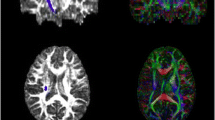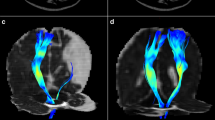Abstract
Background
Several scoring systems for measuring brain injury severity have been developed to standardize the classification of MRI results, which allows for the prediction of functional outcomes to help plan effective interventions for children with cerebral palsy.
Objective
The aim of this study is to use statistical techniques to optimize the clinical utility of a recently proposed template-based scoring method by weighting individual anatomical scores of injury, while maintaining its simplicity by retaining only a subset of scored anatomical regions.
Materials and methods
Seventy-six children with unilateral cerebral palsy were evaluated in terms of upper limb motor function using the Assisting Hand Assessment measure and injuries visible on MRI using a semiquantitative approach. This cohort included 52 children with periventricular white matter injury and 24 with cortical and deep gray matter injuries. A subset of the template-derived cerebral regions was selected using a data-driven region selection algorithm. Linear regression was performed using this subset, with interaction effects excluded.
Results
Linear regression improved multiple correlations between MRI-based and Assisting Hand Assessment scores for both periventricular white matter (R squared increased to 0.45 from 0, P < 0.0001) and cortical and deep gray matter (0.84 from 0.44, P < 0.0001) cohorts. In both cohorts, the data-driven approach retained fewer than 8 of the 40 template-derived anatomical regions.
Conclusion
The equal or better prediction of the clinically meaningful Assisting Hand Assessment measure using fewer anatomical regions highlights the potential of these developments to enable enhanced quantification of injury and prediction of patient motor outcome, while maintaining the clinical expediency of the scoring approach.



Similar content being viewed by others
References
Kuban KCK, Leviton A (1994) Cerebral palsy. N Engl J Med 330:188–195
Oskoui M, Coutinho F, Dykeman J et al (2013) An update on the prevalence of cerebral palsy: a systematic review and meta-analysis. Dev Med Child Neurol 55:509–519
Bax M, Frcp DM, Rosenbaum P et al (2005) Proposed definition and classification of cerebral palsy, April 2005. Dev Med Child Neurol 47:571–576
Himmelmann K, Uvebrant P (2011) Function and neuroimaging in cerebral palsy: a population-based study. Dev Med Child Neurol 53:516–521
Krägeloh-Mann I, Horber V (2007) The role of magnetic resonance imaging in elucidating the pathogenesis of cerebral palsy: a systematic review. Dev Med Child Neurol 49:144–151
Hoon AH, Vasconcellos Faria A (2010) Pathogenesis, neuroimaging and management in children with cerebral palsy born preterm. Dev Disabil Res Rev 16:302–312
Palmer FB (2004) Strategies for the early diagnosis of cerebral palsy. J Pediatr 145:S8–S11
Feys H, Eyssen M, Jaspers E et al (2010) Relation between neuroradiological findings and upper limb function in hemiplegic cerebral palsy. Eur J Paediatr Neurol 14:169–177
Korzeniewski SJ, Birbeck G, DeLano MC et al (2008) A systematic review of neuroimaging for cerebral palsy. J Child Neurol 23:216–227
Shiran SI, Weinstein M, Sirota-Cohen C et al (2014) MRI-based radiologic scoring system for extent of brain injury in children with hemiplegia. AJNR Am J Neuroradiol 35:2388–2396
Kidokoro H, Neil JJ, Inder TE (2013) New MR imaging assessment tool to define brain abnormalities in very preterm infants at term. AJNR Am J Neuroradiol 34:2208–2214
Inder TE, Wells SJ, Mogridge NB et al (2003) Defining the nature of the cerebral abnormalities in the premature infant: a qualitative magnetic resonance imaging study. J Pediatr 143:171–179
Sie LTL, Hart AAM, van Hof J et al (2005) Predictive value of neonatal MRI with respect to late MRI findings and clinical outcome. A study in infants with periventricular densities on neonatal ultrasound. Neuropediatrics 36:78–89
Miller SP, Ferriero DM, Leonard C et al (2005) Early brain injury in premature newborns detected with magnetic resonance imaging is associated with adverse early neurodevelopmental outcome. J Pediatr 147:609–616
Fiori S, Cioni G, Klingels K et al (2014) Reliability of a novel, semi-quantitative scale for classification of structural brain magnetic resonance imaging in children with cerebral palsy. Dev Med Child Neurol 56:839–845
Skiöld B, Eriksson C, Eliasson A-C et al (2013) General movements and magnetic resonance imaging in the prediction of neuromotor outcome in children born extremely preterm. Early Hum Dev 89:467–472
Kulak W, Sobaniec W, Kubas B et al (2007) Spastic cerebral palsy: clinical magnetic resonance imaging correlation of 129 children. J Child Neurol 22:8–14
Yokochi K, Aiba K, Horie M et al (2008) Magnetic resonance imaging in children with spastic diplegia: correlation with the severity of their motor and mental abnormality. Dev Med Child Neurol 33:18–25
Cioni G (2000) Correlation between visual function, neurodevelopmental outcome, and magnetic resonance imaging findings in infants with periventricular leucomalacia. Arch Dis Child Fetal Neonatal Ed 82:F134–F140
Mercuri E, Jongmans M, Bouza H et al (1999) Congenital hemiplegia in children at school age: assessment of hand function in the non-hemiplegic hand and correlation with MRI. Neuropediatrics 30:8–13
De Vries LS, Rademaker KJ, Groenendaal F et al (1998) Correlation between neonatal cranial ultrasound, MRI in infancy and neurodevelopmental outcome in infants with a large intraventricular haemorrhage with or without unilateral parenchymal involvement. Neuropediatrics 29:180–188
Boyd RN, Ziviani J, Sakzewski L et al (2013) COMBIT: protocol of a randomised comparison trial of COMbined modified constraint induced movement therapy and bimanual intensive training with distributed model of standard upper limb rehabilitation in children with congenital hemiplegia. BMC Neurol 13:68
Boyd RN, Mitchell LE, James ST et al (2013) Move it to improve it (Mitii): study protocol of a randomised controlled trial of a novel web-based multimodal training program for children and adolescents with cerebral palsy. BMJ Open 3. doi: 10.1136/bmjopen-2013-002853
Talairach J, Tournoux P (1988) Co-planar stereotaxic atlas of the human brain. 3-D proportional system: an approach to cerebral imaging. Thieme, New York
Krumlinde-Sundholm L, Holmefur M, Kottorp A et al (2007) The Assisting Hand Assessment: current evidence of validity, reliability, and responsiveness to change. Dev Med Child Neurol 49:259–264
Rickard T, Romero S, Basso G et al (2000) The calculating brain: an fMRI study. Neuropsychologia 38:325–335
Holmström L, Vollmer B, Tedroff K et al (2010) Hand function in relation to brain lesions and corticomotor-projection pattern in children with unilateral cerebral palsy. Dev Med Child Neurol 52:145–152
Aisen ML, Kerkovich D, Mast J et al (2011) Cerebral palsy: clinical care and neurological rehabilitation. Lancet Neurol 10:844–852
The R Development Core Team (2008) R: A language and environment for statistical computing. R Foundation for Statistical Computing http://www.blopig.com/blog/2013/07/citing-r-packages-in-your-thesispaperassignments/)
Shapiro SS, Wilk MB (1965) An analysis of variance test for normality (complete samples). Biometrika 52:591–611
Sugiura N (2007) Further analysts of the data by Akaike’s information criterion and the finite corrections. Commun Stat Theory Methods 7:13–26
Hikosaka O, Sakamoto M, Usui S (1989) Functional properties of monkey caudate neurons. I. Activities related to saccadic eye movements. J Neurophysiol 61:780–798
Herrero M-T, Barcia C, Navarro JM (2002) Functional anatomy of thalamus and basal ganglia. Childs Nerv Syst 18:386–404
Doya K (2000) Complementary roles of basal ganglia and cerebellum in learning and motor control. Curr Opin Neurobiol 10:732–739
Takakusaki K, Saitoh K, Harada H et al (2004) Role of basal ganglia-brainstem pathways in the control of motor behaviors. Neurosci Res 50:137–151
Wahl M, Lauterbach-Soon B, Hattingen E et al (2007) Human motor corpus callosum: topography, somatotopy, and link between microstructure and function. J Neurosci 27:12132–12138
Barkovich AJ, Guerrini R, Kuzniecky RI et al (2012) A developmental and genetic classification for malformations of cortical development: update 2012. Brain 135:1348–1369
Leong S (1997) Is there a zone of vascular vulnerability in the fetal brain stem? Neurotoxicol Teratol 19:265–275
Hetts SW, Sherr EH, Chao S et al (2006) Anomalies of the corpus callosum: an MR analysis of the phenotypic spectrum of associated malformations. AJR Am J Roentgenol 187:1343–1348
Stoerig P (2006) Blindsight, conscious vision, and the role of primary visual cortex. Prog Brain Res 155:217–234
Owen AM, Downes JJ, Sahakian BJ et al (1990) Planning and spatial working memory following frontal lobe lesions in man. Neuropsychologia 28:1021–1034
Eichenbaum H, Yonelinas AP, Ranganath C (2007) The medial temporal lobe and recognition memory. Annu Rev Neurosci 30:123–152
Rose S, Guzzetta A, Pannek K et al (2011) MRI structural connectivity, disruption of primary sensorimotor pathways, and hand function in cerebral palsy. Brain Connect 1:309–316
Chapman SB, Max JE, Gamino JF et al (2003) Discourse plasticity in children after stroke: age at injury and lesion effects. Pediatr Neurol 29:34–41. doi: 10.1016/S0887-8994(03)00012-2
Belsky J, Pluess M (2009) The nature (and nurture?) of plasticity in early human development. Perspect Psychol Sci 4:345–351
Fiori S, Guzzetta A, Pannek K et al (2015) Validity of semi-quantitative scale for brain MRI in unilateral cerebral palsy due to periventricular white matter lesions: relationship with hand sensorimotor function and structural connectivity. NeuroImage Clin 8:104–109
Acknowledgments
Alex Pagnozzi is supported by the Australian Postgraduate Award (APA) from the University of Queensland and a stipend from the Commonwealth Scientific Industrial and Research Organisation (CSIRO). Roslyn Boyd is supported by a NHMRC Career Development Fellowship (1037220) and a NHMRC Project Grant COMBIT (1003887). No other authors have potential conflicts of interest to declare.
Author information
Authors and Affiliations
Corresponding author
Ethics declarations
Compliance with Ethical Standard
ᅟ
Conflicts of interest
None
Electronic supplementary material
Below is the link to the electronic supplementary material.
Suppl Fig 1
(GIF 137 kb)
Suppl Fig 2
(GIF 152 kb)
ESM 1
(DOC 34 kb)
Rights and permissions
About this article
Cite this article
Pagnozzi, A.M., Fiori, S., Boyd, R.N. et al. Optimization of MRI-based scoring scales of brain injury severity in children with unilateral cerebral palsy. Pediatr Radiol 46, 270–279 (2016). https://doi.org/10.1007/s00247-015-3473-y
Received:
Revised:
Accepted:
Published:
Issue Date:
DOI: https://doi.org/10.1007/s00247-015-3473-y




